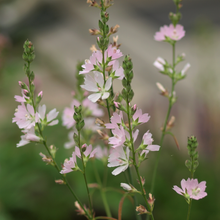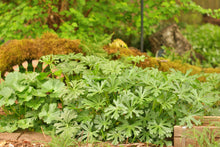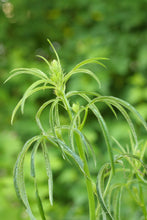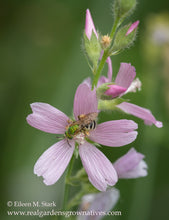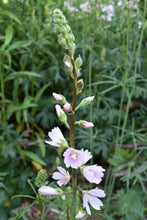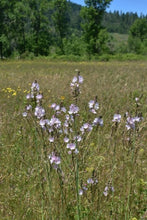
Sidalcea campestris
Only found in the Willamette Valley, showy meadow checkermallow is becoming increasingly rare in natural environments. Thankfully, gardeners are beginning to see the amazing esthetic and habitat value of this wildflower. In spring, the foliage emerges in rather tidy mounds of rounded leaves, divided palmately to narrow, toothed segments. Its summer flowers are remarkably long-lasting, white-to-blush blooms standing gorgeously on hollyhock-like stems that are often tall enough to look you in the eye. It is one of the absolute best butterfly plants in the Pacific Northwest and an abundant source of nectar for native bees and hummingbirds.
- Plant type/canopy layer: deciduous, perennial, herbaceous plant
- Size at maturity: 24-60" tall (flower stalk, foliage much shorter), 8”-24" wide
- Light requirements: full sun, part sun/part-shade
- Moisture requirements: dry to moist soil
- Bloom time: May - August (June - August in the Portland Metro area)
- Growth rate/ease: fast growing, easy to grow
- Wildlife support: flowers are a nectar source for adult butterflies and hummingbirds and a source of both pollen/nectar for native bees and other insect pollinators, including being the primary pollen source for the rare native bee, Diadasia nigrifrons; overall plant attracts and supports other beneficial and pest eating insects and is a caterpillar host plant and larval food source for many butterflies including the Fender's blue (Icarioides fenderi), American lady (Vanessa virginiensis), West Coast lady (V. annabella), painted lady (V. cardui), checkered skipper (Pyrgus communis) and gray hairstreak (Strymon melinus)
- Native habitat/range: grows in pastures, fields and along roadsides almost exclusively in the Willamette Valley. Beyond a few remnant populations, this plant is now largely extinct in the wild. Portland Plant List - yes.
- Special features & uses: wildlife and pollinator favorite, including hummingbirds; drought tolerant; landscape uses include meadowscapes and pollinator gardens; makes a good cut flower
Gardening with Meadow Checkermallow: This long-lived perennial prefers meadow-like conditions that are mostly sunny. Like most plants, it prefers well-drained soils - but it will tolerate heavy clay that dries out entirely in the summer. Established plants are highly drought tolerant and will form clumps up to 2′ wide. For the best pollinator benefit, plant several and allow it to grow in broad swaths, creating large areas of dusty pink blooms. You’ll also be aiding in the recovery of this species of conservation concern in Oregon, where roadside spraying programs threaten its limited, remaining wild populations.
Plant with other Oregon white oak woodland associates like wild roses (Rosa sp.), Oregon iris (Iris tenax), lupine (Lupinus sp.), shooting stars (Dodecatheon sp.), and native bunch grasses.
Photo Credit 1 (flowering stalks): "Sidalcea campestris inflorescence" by Flowersinmyyard is licensed under CC BY-SA 4.0.
Photo Credit 2 & 3 (foliage, buds): Karli Del Biondo, Beetles and Bees
Photo Credit 4 (flower closeup): Eileen Stark, Real Gardens Grow Natives
Photo Credit 5 (flower stalk): Nikkie West, Sparrowhawk Native Plants
Photo Credits 6 (in the wild): © Gail A Baker, some rights reserved (CC-BY)






